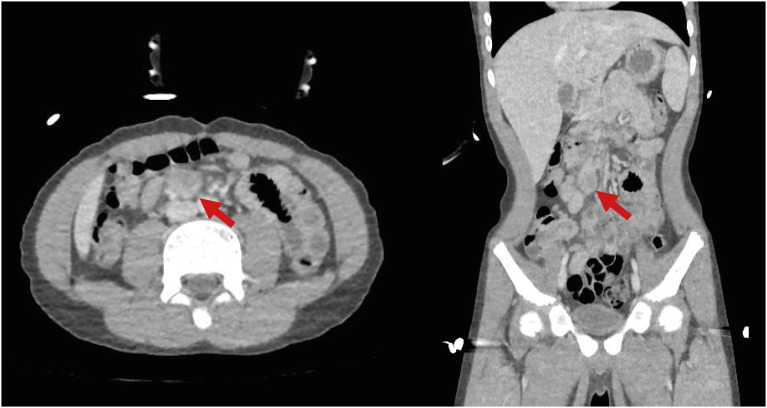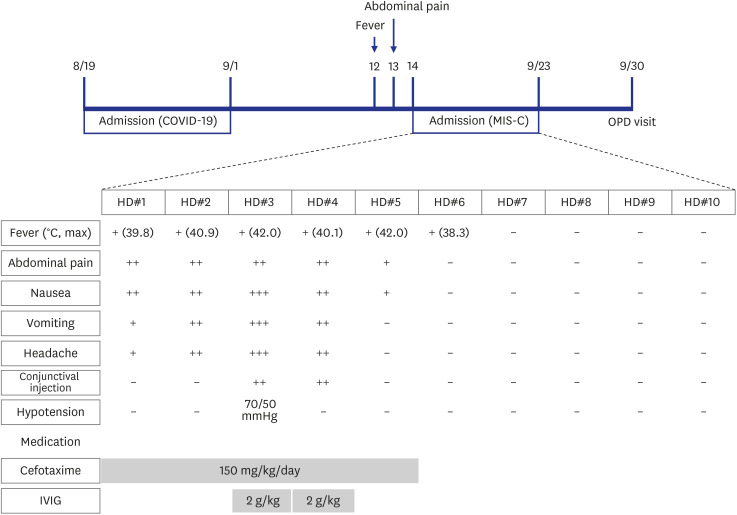J Korean Med Sci.
2021 Jan;36(2):e17. 10.3346/jkms.2021.36.e17.
The Importance of Early Recognition, Timely Management, and the Role of Healthcare Providers in Multisystem Inflammatory Syndrome in Children
- Affiliations
-
- 1Department of Pediatrics, College of Medicine, Chungbuk National University, Cheongju, Korea
- 2Department of Pediatrics, Chungbuk National University Hospital, Cheongju, Korea
- 3Department of Infection Control and Prevention, Chungbuk National University Hospital, Cheongju, Korea
- KMID: 2510590
- DOI: http://doi.org/10.3346/jkms.2021.36.e17
Abstract
- In April 2020, a pediatric report of an unusual inflammatory illness associated with coronavirus disease 2019 (COVID-19) led to similar cases in Europe and North America, which was referred to as multisystem inflammatory syndrome in children (MIS-C). Herein, we describe the case of a 12-year-old boy who had a history of polymerase chain reactionconfirmed COVID-19 and developed MIS-C approximately three weeks after an initial diagnosis of COVID-19. High fever with abdominal pain mimicking appendicitis was the initial manifestation of MIS-C, which could have been easily missed if the patient's history of COVID-19 was ignored. Intravenous immunoglobulin was administered twice, 24 hours apart, five days after the onset of MIS-C, and the patient fully recovered without any obvious sequelae. Early recognition by disease awareness and prompt management are the keys to saving the lives of children affected by MIS-C.
Figure
Cited by 1 articles
-
The First Case of Multisystem Inflammatory Syndrome in Adult after COVID-19 in Korea
Hyemin Chung, Hyeonji Seo, Sunghee Park, Haein Kim, Jiwon Jung, Yong Pil Chong, Sung-Han Kim, Sang-Oh Lee, Sang-Ho Choi, Yang Soo Kim, Min Jae Kim
J Korean Med Sci. 2021;36(25):e181. doi: 10.3346/jkms.2021.36.e181.
Reference
-
1. Levin M. Childhood multisystem inflammatory syndrome - a new challenge in the pandemic. N Engl J Med. 2020; 383(4):393–395. PMID: 32598829.
Article2. Riphagen S, Gomez X, Gonzalez-Martinez C, Wilkinson N, Theocharis P. Hyperinflammatory shock in children during COVID-19 pandemic. Lancet. 2020; 395(10237):1607–1608. PMID: 32386565.
Article3. Verdoni L, Mazza A, Gervasoni A, Martelli L, Ruggeri M, Ciuffreda M, et al. An outbreak of severe Kawasaki-like disease at the Italian epicentre of the SARS-CoV-2 epidemic: an observational cohort study. Lancet. 2020; 395(10239):1771–1778. PMID: 32410760.
Article4. Feldstein LR, Rose EB, Horwitz SM, Collins JP, Newhams MM, Son MB, et al. Multisystem inflammatory syndrome in U.S. children and adolescents. N Engl J Med. 2020; 383(4):334–346. PMID: 32598831.
Article5. Rowley AH, Shulman ST, Arditi M. Immune pathogenesis of COVID-19-related multisystem inflammatory syndrome in children. J Clin Invest. 2020; 130(11):5619–5621. PMID: 32870815.
Article6. Kim H, Shim JY, Ko JH, Yang A, Shim JW, Kim DS, et al. Multisystem inflammatory syndrome in children related to COVID-19: the first case in Korea. J Korean Med Sci. 2020; 35(43):e391. PMID: 33169560.
Article7. Hennon TR, Penque MD, Abdul-Aziz R, Alibrahim OS, McGreevy MB, Prout AJ, et al. COVID-19 associated multisystem inflammatory syndrome in children (MIS-C) guidelines; a Western New York approach. Prog Pediatr Cardiol. 2020; 57:101232.
Article8. Son MB, Friedman K. Coronavirus disease 2019 (COVID-19): multisystem inflammatory syndrome in children (MIS-C) management and outcome. In : Armsby C, TePas E, editors. UpToDate. Waltham, MA: UpToDate;2020. Updated September 25, 2020. Accessed October 14, 2020.9. Henderson LA, Canna SW, Friedman KG, Gorelik M, Lapidus SK, Bassiri H, et al. American College of Rheumatology Clinical Guidance for multisystem inflammatory syndrome in children associated with SARS-CoV-2 and hyperinflammation in pediatric COVID-19: version 1. Arthritis Rheumatol. 2020; 72(11):1791–1805. PMID: 32705809.
Article10. Dulek DE, Fuhlbrigge RC, Tribble AC, Connelly JA, Loi MM, El Chebib H, et al. Multidisciplinary guidance regarding the use of immunomodulatory therapies for acute COVID-19 in pediatric patients. J Pediatric Infect Dis Soc. 2020; piaa098. PMID: 32808988.11. Guo Y, Tian X, Wang X, Xiao Z. Adverse effects of immunoglobulin therapy. Front Immunol. 2018; 9:1299. PMID: 29951056.
Article12. McCrindle BW, Rowley AH, Newburger JW, Burns JC, Bolger AF, Gewitz M, et al. Diagnosis, treatment, and long-term management of Kawasaki disease: a scientific statement for health professionals from the American Heart Association. Circulation. 2017; 135(17):e927–e999. PMID: 28356445.
Article13. Han MS, Choi EH, Chang SH, Jin BL, Lee EJ, Kim BN, et al. Clinical characteristics and viral RNA detection in children with coronavirus disease 2019 in the Republic of Korea. JAMA Pediatr. Forthcoming 2020. DOI: 10.1001/jamapediatrics.2020.3988.
Article14. Kim SC, Kong SY, Park GJ, Lee JH, Lee JK, Lee MS, et al. Effectiveness of negative pressure isolation stretcher and rooms for SARS-CoV-2 nosocomial infection control and maintenance of South Korean emergency department capacity. Am J Emerg Med. Forthcoming 2020. DOI: 10.1016/j.ajem.2020.09.081.
Article
- Full Text Links
- Actions
-
Cited
- CITED
-
- Close
- Share
- Similar articles
-
- A case of multisystem inflammatory syndrome in children associated with coronavirus disease 2019, presenting as unremitting fever, vomiting, and rash
- Multisystem Inflammatory Syndrome in Adults in an 80-Year-Old Korean Woman after COVID-19: A Case Report
- Clinical and Laboratory Characteristics of Kawasaki Disease and COVID-19-Related Multisystem Inflammatory Syndrome in Children
- Clinical spectrum and short-term outcomes of multisystem inflammatory syndrome in children in a south Indian hospital
- Comparison of COVID-19-associated multisystem inflammatory syndrome in children (MIS-C) and Kawasaki disease shock syndrome: case reports and literature review



